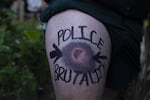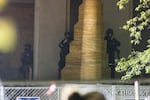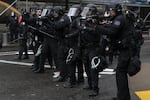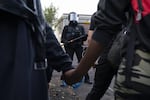Steven Weiss was protesting in front of the Multnomah County Justice Center. It was June 19, three weeks into near nightly protests against systemic racism and police violence. Those protests routinely culminate each night with police resorting to violence to disperse hundreds of nonviolent protesters.
Weiss said the crowd that night was energetic, but overall it was a calm evening. People were chanting and yelling anti-police and Black Lives Matter slogans. There was a group across the street in the park grilling. By 11 p.m., the police still hadn’t been visible, staying inside the building and out of sight instead.
“Up until the police came charging out,” Weiss said, “I didn't really see any projectiles thrown except for a couple eggs.”
Weiss was standing toward the back of the crowd, across the street from the Justice Center, when he said a handful of police came rushing out of the building and started shooting impact munitions.
“Through the fence, over the fence,” Weiss said. “And at that point they were still just taking shots into the general crowd.”
Weiss recalled hearing the police firing into the crowd, a young girl in front of him got shot in the leg, a medic hiding behind a rock also got shot in the leg. Weiss said he put his hands up and was pacing back and forth when he was shot above his right pec with a 40mm foam impact munition.
PPB guidelines require officers firing at targets more than 7 yards away to aim impact munitions anywhere below the waist except the groin. Weiss was more than 30 yards away from the officers who were firing.
Moments after Weiss was shot, a person standing in front of him got shot in the head and started bleeding profusely. A week later, that person — who didn’t want to be interviewed because they are pursuing litigation — said they were still suffering dizzy spells. For days after Weiss was shot, he said he had a hard time bending over or using his right arm.
Related: Police Deploy Tear Gas In North Portland As Protesters Seek Sanctions
The Portland Police Bureau is facing increasing scrutiny for its use of so-called "less lethal" munitions to control protests. But even as demonstrators, civil rights groups, and local and state lawmakers have called for limits on the weapons, police have continued to use them when tensions escalate. Two months of protests and a court order seem to have done little to change how police disperse crowds in the city.
On June 1, three days after predominantly non-violent protests ended with a handful of protesters breaking windows and setting a small fire in the ground floor of the Justice Center, records show the Portland Police Bureau spent $48,000 on tear gas, pepper spray, 40mm foam munitions, and various kinds of grenades designed to create noise, emit smoke, or inflict pain.
According to doctors and weapons experts who have studied the effects of these and other riot control weapons, it is impossible for PPB, the Multnomah County Sheriff’s Office and other law enforcement agencies to employ them in a way that does not risk severe injury, or even death, to protesters.
“We really don't see a role for kinetic projectiles in crowd control,” said Dr. Rohini Haar, an ER doctor in Oakland, California, and a medical expert at Physicians for Human Rights who studies crowd control weapons, “because there's really no safe way to use them.”
Impact munitions often penetrate the skin whether they're fired from far away or close in, Haar said. Those injuries can require stitches or leave permanent scars. Haar led a study that found 3% of people struck by impact munitions die and 15% suffer permanent disability. She said the weapons are particularly dangerous if a munition hits someone in their neck or face.
“If they directly penetrate the eye, you're going to have permanent blindness or some level of permanent blindness,” Haar said. “What we see is also some significant injuries when they hit the delicate parts of the neck. Almost all of the important things that are necessary for survival go through your neck in one way or another.”

A man who says Portland police shot him in the leg at close range with a 40mm foam munition shows the bruise it left during the sixth night of protests over the killing of George Floyd, a Black man from Minneapolis who was killed after an officer pushed his knee into his neck for nearly nine minutes.
Jonathan Levinson / OPB
On May 29, Minneapolis police shot freelance journalist Linda Tirado in the eye with an impact munition, causing her to lose her eye. In June, the American Academy of Ophthalmologists and the University of California, San Francisco launched a registry for ophthalmologists, finding at least 20 people nationwide have suffered traumatic eye injuries from impact munitions since protests began. Many have lost an eye.
Among the $50,000 Portland police spent on June 1, PPB bought $4,375 worth of Stinger grenades, which detonate and send a blast of small rubber pellets the size of a blueberry at bystanders. On June 27 in Portland, descriptions and photos indicate the police used one of those grenades. A pellet became lodged inside a protester's eye who, after being treated at the hospital, defied overwhelming odds and kept his eye.
“If the police officer wouldn't just walk into the crowd and randomly swing their baton and try to hit everybody in arm's length,” said Brian Castner, a weapons investigator for Amnesty International’s crisis team, “if they're not willing to do that, which I would argue they should not, then why would you use a Stinger ball grenade that effectively does the same thing?”
The Stinger grenade is one of many different riot control agents and crowd control munitions in use by the Portland Police Bureau and Multnomah County Sheriff’s Office. Colloquially known as tear gas and rubber bullets, these weapons come in a number of different forms and can be thrown into crowds using grenades, like the Stinger, or fired into crowds using launchers.
PPB’s Rapid Response Team uses a riot gun called the FN 303 to fire small plastic bullets at individuals. Those plastic rounds are used for what PPB calls “pain compliance” to get an individual to change their behavior. The FN 303 can also fire rounds with OC powder, or tear gas.
The gun's manufacturer, FN Herstal, says the gun is "extremely accurate" to 50 meters. But a 2019 study done at the Royal Military Academy in Belgium found that when operators are under stress, the weapon's vertical accuracy past 30 meters (98 feet) was significantly impacted — meaning someone aiming at the chest might accidentally hit above or below, like the neck, face or groin.

Police on the steps of the Multnomah County Justice Center aim less lethal weapons at protesters demonstrating against police brutality and racist violence in Portland, Ore., June 5, 2020.
Jonathan Levinson / OPB
On many nights at the Justice Center, officers have been seen firing FN 303 rounds from the front steps of the building into crowds of nonviolent protesters standing in the park across the street, just over 100 feet away.
In 2004, the Boston Police Department stopped using the FN 303 after police shot and killed 21-year-old Victoria Snelgrove with the weapon while dispersing crowds celebrating the Boston Red Sox World Series victory.
That was the first and only time Boston police used the weapons. Three years later, they were melted down to make sewer caps and Boston Police Commissioner Ed Davis called the weapons "an inherent problem" because they were more powerful and lethal than had been anticipated.
Both PPB and MCSO also use 40mm launchers to fire foam tipped impact munitions at individuals and to dispense smoke or tear gas over a crowd. Despite the name, the foam itself is hard and can cause lacerations, break bones and cause head injuries, according to Castner and Haar.
Based on munitions found on the ground after they were shot, it was likely a 40mm eXact iMpact sponge round that struck Weiss in the chest and the man's head who was standing in front of him. On May 30, a Los Angeles police officer fired a 40mm round and struck Jasmine Morales, 26, while she was sitting in her car at an intersection near where a protest was happening. Morales, who was on her way to Target, needed stitches, suffered a fractured cheekbone and sustained a brain injury.
“These weapons are dangerous,” said Castner, the expert from Amnesty International. “And they can both kill people and cause life-changing injuries like loss of eyes, cracked skulls, cracked jaws. Truly debilitative injuries from these weapons.”
Castner said the 40mm launchers have an added layer of complexity because they shoot different types of munitions, which are each used a different way.
“If you're firing tear gas, you shouldn't be firing at people,” Castner said. “But if you have one sponge round, then that's only appropriate to shoot at a single person committing a violent act.”

Portland police fire pepper spray, FN 303 plastic munitions, and aim a 40mm launcher while dispersing protesters from near the Justice Center an hour before the 8 p.m. curfew went into effect on May 30, 2020. The protests were against racist violence and police brutality in the wake of the Minneapolis police killing of George Floyd.
Jonathan Levinson / OPB
Neither PPB nor MCSO responded to questions about how officers train on the various impact munitions they use. In a June 4 press briefing, Rapid Response Team commander Lt. Franz Schoening said these munitions are safer than the alternative.
“Without specialized equipment and munitions, the alternative is physical force, person to person using a stick or something like that,” Schoening said. “If you end up fighting physically with someone and having to put them on the ground or using your stick to try and push someone, there’s a higher risk of injury with that then there is with our specialized munitions.”
Attorneys who are suing the city said that’s a false dichotomy.
“You don't hear them saying that about choke holds,” said Juan Chavez, one of the lawyers representing Oregon protesters in a federal lawsuit. “You can't stop us from using choke holds because otherwise we're going to have to use baton strikes on kneecaps.”

Thousands of people took to the streets in largely peaceful protests on May 31, 2020. The protests ultimately ended with police using tear gas and rubber bullets to disperse the crowd gathered around the Justice Center in downtown Portland.
Jonathan Levinson / OPB
The Portland lawsuit is one of more than 40 filed so far across the country in cities like Sacramento, Indianapolis, Pittsburgh and Charlotte.
In Portland, a group of protesters sued in federal court over PPB's use of tear gas. That was eventually expanded to include impact munitions. The judge in that case issued a temporary restraining order requiring the Portland Police Bureau to follow its existing guidelines, and explicitly said impact munitions "shall not be used where people engaged in passive resistance are likely to be subjected to the force."
“When the police are confronted with people demanding these changes, they reacted violently,” Chavez said. “What we kept seeing night after night was people who were, at most, passively resistant to the tactics getting tear gassed or getting shot with impact weapons.”
Related: Portland Police Chief Says Injuries 'More Likely' If Gas Is Restricted
Fundamentally, Chavez said, police already have an effective way of dealing with people who are causing violence at protests: arrests.
“What the rules say is that they should be arrested,” Chavez said. “Not, 95% of other people who are at that protest get tear gassed or get hit with impact munitions.”
On Wednesday, the day after PPB used tear gas to disperse predominantly non-violent protesters in North Portland and arrested three journalists covering the demonstration, City Commissioner Jo Ann Hardesty sent a letter to Police Chief Chuck Lovell.
“We have witnessed the bureau’s operations become more outlandish in the past week and a half,” Hardesty wrote, “as the court, city, & state have given limits & boundaries to police conduct.”
Hardesty said Portlanders are exercising their rights to assembly and proceeded to outline a list of requests, including discontinuing the use of tear gas and “close-range rubber bullets.”
Dr. Bryan Wolf is an assistant professor and radiologist at OHSU. For the past two weeks, he has been a faculty volunteer for a group of OHSU students providing things like ear plugs, masks and water to protesters. Some of the students are also EMTs and have provided first aid when necessary.
He was at the Justice Center with the students June 19, the same night Weiss was shot.
“The Juneteenth event was the most concerning to me because they were legitimately just standing around,” Wolf said. “It was just a quiet, nice night. And there was no provocation when the Justice Center doors were opened and the police opened fire on the crowd.”
A week later, on June 26, the same day a federal judge issued the temporary restraining order, the students said they treated about 15 people for injuries, at least five of whom had been hit with impact munitions.
One person, who had been shot in the head, was unconscious and bleeding, Wolf said. One of the OHSU students, along with several street medics, tried to provide first aid.
“The police were not allowing ambulances to arrive on scene to care for that person,” he said. “So this team of medics carried this man some distance in the middle of which he started convulsing and seizing.”
Eventually, he said, a medic from the Justice Center came out and allowed an ambulance to enter.
Wolf said the experience of standing out there, in a white coat clearly marked as a doctor providing medical assistance, has made him realize the depths of police brutality. He said he’s seen unprovoked assaults on protesters, physical harm and a failure to protect people exercising their constitutional rights.
“If the privilege that white coat affords me doesn’t protect me from this, then what is protecting the community?” Wolf asked. “It’s just a flagrant attack on our community.”
